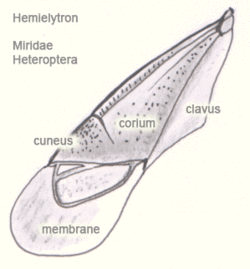| Miridae | |
|---|---|
 | |
| Rhabdomiris striatellus | |
| Scientific classification | |
| Kingdom: | Animalia |
| Phylum: | Arthropoda |
| Class: | Insecta |
| Order: | Hemiptera |
| Suborder: | Heteroptera |
| Superfamily: | Miroidea |
| Family: | Miridae Hahn, 1831 |
| Type species | |
| Cimex striatus L. | |
| Subfamilies | |
| |
| Synonyms | |
Capsidae Burmeister, 1835 | |
The Miridae are a large and diverse insect family at one time known by the taxonomic synonym Capsidae. [1] Species in the family may be referred to as capsid bugs or "mirid bugs". Common names include plant bugs, leaf bugs, and grass bugs. It is the largest family of true bugs (suborder Heteroptera); it includes over 10,000 known species, and new ones are being described constantly. Most widely known mirids are species that are notorious agricultural pests that pierce plant tissues, feed on the sap, and sometimes transmit viral plant diseases. Some species however, are predatory.


